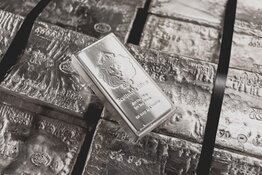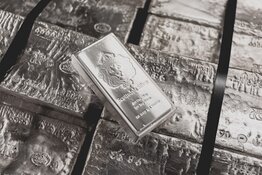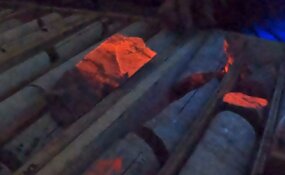Interviewed mid-December Sprott, who is a major investor in physical and silver equities, explained why he wrote his letter. "I have always liked silver because I look at the physical supply and demand metrics and they scream that silver should be higher. But the price is being kept down by paper silver traders who are abusing the market."
As proof, Sprott pointed to the day last April when silver hit $50 an ounce (oz) and then immediately dropped $6/oz in 13 minutes when almost none of the markets were open. "A billion ounces of paper silver traded that day. The mining industry only produces about 700 million ounces (Moz) a year. The major financial institutions, which had been shorting silver for a long time, refused to let silver break $50/oz so they manipulated the market to keep a lid on it," Sprott charged.
"That is why I think the physical silver producers, the miners, need to be more active participants in the market," Sprott explained. "When silver is produced for less than $15/oz and sold for $30/oz, theoretically the producer is making $15/oz. I believe it is irresponsible for companies to leave that money in the bank where it is vulnerable. It is too risky. Producers have to find something to invest in and the obvious choices are gold and silver. It seems very logical to me that silver producers should invest in silver as a monetary metal."
"I'm not trying to create a Hunt Brothers type situation," he said, referring to when Nelson and William Hunt tried to corner the silver market in the late 1970s by buying as much as a third of the world's supply, driving the price up to almost $50/oz before the market crashed on Silver Thursday. "I'm just trying to create a fair playing field. Producers should take their future into their own hands," he said.
To those who compare his call for silver producers to act in concert to the methods of an oil cartel, Sprott said he agreed with the business model. "OPEC [Organization of the Petroleum Exporting Countries] was right that the price of oil was ridiculously cheap. Coming together to control supply was probably one of the more responsible things oil producers did. They were being disadvantaged and they took appropriate action. I think that's what the silver industry should do," he said.
As a major silver owner, Sprott could profit if holding silver reduces supply and results in a higher silver price, but so would other equity holders, he said. "Silver producers and their shareholders are the ones who are most effected and yet they aren't even involved in a pair of lawsuits against J.P. Morgan Chase and HSBC Holdings Inc. for silver market manipulation going back to 2008. Producers have to get themselves in it. They have to understand what's happening in the game. How can we let some guy manipulate the price of silver down and stand back and do nothing?" he asked rhetorically. "This [letter] was born out of frustration with the paper market and doubts about the banking system. Having money at a bank is taking on inordinate risk because when things start to implode, capital can be eaten away in no time."
Holding back a little can make a big difference, Sprott suggested. "It just takes a bit of a groundswell. When I look at the supply/demand for silver, it's a very, very tight market. It wouldn't take many ounces to have an impact. The COMEX [Commodity Exchange Inc.] has about 30 Moz or $1 billion of deliverable silver. That is not a lot of money in this day and age for all of the producers," he said. He estimated that if the silver producers put 15% of their cash balances back into silver it would reduce the silver supply by 21%; that would result in a shortage of supply for industry purposes, let alone investing, and drive up the price. "If you are in the silver business, put your money into silver and stop the paper guys from knocking the price around," he said.
"The key thing is just to get a momentum change," Sprott said. "I would like the CEOs of silver companies to think about the silver market. Let's not just think about tons and grade and recovery. Let's deal with what is going on in the market in a rational way."
Sprott says he has had some positive responses to his letter from major producers. "I know it's under consideration by a lot of people," he said.
Like a number of other major producers, Samantha Stevens, vice president of media relations at BHP Billiton Ltd. (BHP:NYSE; BHPLF:OTCPK), declined to be interviewed, but said in an email: "BHP Billiton's philosophy is to produce at maximum volumes, while sitting at the low end of the cost curve and take the price of the day (market price)." BHP Billiton produced 9.151 Moz of silver in the quarter ending in September and is listed as the top silver producing company in 2010 by The Silver Institute.
At Pan American Silver Corp. (PAA:TSX; PAAS: NASDAQ), which reported production of 5.6 Moz in the third quarter of 2011, CEO and President Geoff Burns had not seen the letter, but said in general holding silver is not his business. "We are already incredibly long silver with 1 billion ounces in the ground. We create value for our shareholders by mining and turning that silver into cash flow. We will continue to sell silver on the spot market," he said.
Endeavour Silver Corp. (EDR:TSX; EXK:NYSE) Chairman and CEO Bradford Cooke said his company, which reported 858,738 oz of production in the third quarter and counts Sprott as an investor, has been putting excess cash in silver and gold on a short-term basis since 2008. "We are bullish on the market and recognize that it has annual cycles so we sometimes park some until the next quarter when the price might be higher unless there are other opportunity investments for the company," he said. Cooke noted that Endeavour usually sells all of its holdings by year-end for reporting purposes.
Cooke said he appreciated Sprott's call to action. He predicted that the silver price is on the way up regardless, although the sector could be "sloppy" for the next nine months while global uncertainty works its way out. "Gold and silver will be the first sectors to start moving in 2012," he said.
The move up will probably not be driven by anything silver producers do, however, Cooke said. "I don't think producers have enough cash to impact the price of silver enough to make a difference globally," he said. "We can make an impact to individual balance sheets," he added.
Silver Investor Publisher David Morgan also said he liked the idea of companies investing in their own product, but didn't think they could impact the price of the metal materially unless every mine in the world participated. "It has been tried before," he said. The challenge, according to Morgan, is that the market is controlled by big players, most of which are not exclusively silver producers since as much as 70% of production is the result of byproducts from mining for other metals. "What the practice can do," Morgan said, "is add value for investors and differentiate companies by creating a premium for their share price."
Even if producers holding silver don't push up the price, Sprott is convinced companies that hold silver will benefit from delaying the sale of the metal because geo-economic forces will increase silver's attractiveness anyway. He cited rising demand for silver from an additional 4.3 billion people in Asia and South America. This increasing hunger for the metal for industrial and investment purposes was demonstrated in September's historic sale of physical silver coins and China's importation of 7.7 Moz of silver that same month. "Silver will go up on its own. But the silver industry could aid and abet the situation. Then companies will be double winners. The stock will go up because silver is going up and the company will make more money because it was not in a bank.
"I think the price should already be substantially higher," Sprott said. "The trade should be 16:1 gold:silver ratio. That implies that at $1,600/oz gold, silver should be $100/oz. At $3,200/oz gold, silver should be $200/oz. The outlook for gold is phenomenal and silver is going to go up even faster. That is why I think that this next decade will be the decade for silver," Sprott predicted.
From time to time, Streetwise Reports LLC and its directors, officers, employees or members of their families, as well as persons interviewed for articles on the site, may have a long or short position in securities mentioned and may make purchases and/or sales of those securities in the open market or otherwise.









































